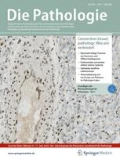Zusammenfassung
Das „Blue Book“ der WHO-Klassifikation hämatolymphoider Neoplasien stellt die weltweit akzeptierte Referenz für die Diagnose myeloischer und lymphatischer Tumoren dar. Sie beruht zu großen Teilen auf der REAL-Klassifikation von 1994 [2] und wurde kontinuierlich weiterentwickelt und präzisiert [3, 5, 6]. In der in diesem Jahr erscheinenden 5. Ausgabe werden neuere Erkenntnisse zur Pathogenese und Molekulargenetik sowie neue Konzepte zur taxonomischen Basis der Klassifikation berücksichtigt. Übersichten zu den Änderungen bzw. Neuerungen in der 5. Ausgabe der WHO-Klassifikation hämatolymphoider Neoplasien (WHO-HAEM5) sind jüngst erschienen [1, 4]. Die Kapitel wurden von 420 Autoren, darunter zahlreiche Mitglieder der großen internationalen hämatopathologischen Gesellschaften, der European Association for Haematopathology (EAHP) und der Society for Hematopathology (SH) im Rahmen eines multidisziplinären Ansatzes unter Beteiligung von Hämatopathologen, Hämatologen, Onkologen, Genetikern, Epidemiologen und Molekularbiologen verfasst. Die Inhalte der Kapitel wurden in zahlreichen Online-Meetings diskutiert und untereinander und mit den anderen Bänden der 5. Ausgabe der WHO-Klassifikationen harmonisiert. Eine umfassende Diskussion klinischer Aspekte der Klassifikation fand in einem klinischen Advisory Board statt. Die resultierende WHO-HAEM5 stellt somit eine systematische Entwicklung aus den vorangegangenen Klassifikationen dar. Wie auch die anderen Bände dieser Serie wendet WHO-HAEM5 ein hierarchisches Klassifikationssystem an und ordnet Krankheiten nach steigenden Graden der Spezifizierung: Kategorie (z. B. reifzellige B‑Zell-Neoplasie), Familie/Klasse (diffuses großzelliges B‑Zell-Lymphom, DLBCL), Entität bzw. Typ (DLBCL, nicht weiter spezifiziert [NOS]) und Subtyp (DLBCL, NOS, Keimzentrumstyp). „Essentielle“ Kriterien werden als Minimalkriterien zur Erstellung der Diagnose gegeben, während „wünschenswerte“ Kriterien diejenigen darstellen, die bei der Bestätigung und Spezifizierung der Diagnose helfen.
Abstract
The “Blue Book” of the WHO classification of haematolymphoid tumours is the worldwide accepted reference in malignant tumours of the myeloid and lymphoid system. The REAL classification of 1994 [2] laid the foundations for the WHO volumes, with continous development and specification to date [3, 5, 6]. In the 5th edition of the classification to be released this year, new insights concerning the pathogenesis and molecular genetics, and new concepts regarding the taxonomic basis of the classification are included. Overviews of the changes and new aspects of the 5th edition of the classification of haematolymphoid tumours (WHO-HAEM5) have recently been published [1, 4]. Overall, 420 authors participated on the WHO-HAEM5, among them numerous members of the large international societies for haematopathology, the European Association for Haematopathology (EAHP) and the Society for Hematopathology (SH). The WHO-HAEM5 was developed in a multidisciplinary setting in numerous online meetings with haematopathologists, haematologists, oncologists, geneticists, epidemiologists and molecular biologists. In extensive discussions, harmonisation of chapters and with the other volumes of the 5th series was sought. For implementation of clinical aspects, a clinical advisory board was consulted. The new classification constitutes a systematic update of former classifications. As has been implemented earlier, the entities are presented in a hierarchical order: category (e.g. mature B‑cell neoplasm), family/class (e.g. diffuse large B‑cell lymphoma, DLBCL), entity (e.g. DLBCL, not otherwise specified, NOS) and subtype (e.g. DLBCL, NOS, GCB-type). Similar to the 5th editions of other WHO classifications, at the end of each chapter, a list of “essential” diagnostic criteria representing minimal criteria to establish the diagnosis and “desirable” diagnostic criteria are given in order to further confirm and specify the diagnosis.
Literatur
Alaggio R, Amador C, Anagnostopoulos I et al (2022) The 5th edition of the world health organization classification of haematolymphoid tumours: lymphoid neoplasms. Leukemia 36(7):1720–1748
Harris NL, Jaffe ES, Stein H et al (1994) A revised European-American classification of lymphoid neoplasms: a proposal from the international lymphoma study group. Blood 84:1361–1392
Jaffe ES, Harris N, Stein H et al (Hrsg) (2001) World health organization classification of tumours. Pathology and genetics of tumours of haematopoietic and lymphoid tissues, 3. Aufl. IARC, Lyon
Khoury JD, Solary E, Abla O et al (2022) The 5th edition of the world health organization classification of Haematolymphoid tumours: myeloid and histiocytic/dendritic neoplasms. Leukemia 36(7):1703–1719
Swerdlow SH, Campo E, Harris NL et al (Hrsg) (2008) World health organization classification of tumours of haematopoietic and lymphoid tissues, 4. Aufl. IARC, Lyon
Swerdlow SH, Campo E, Harris NL et al (Hrsg) (2017) World health organization classification of tumours of haematopoietic and lymphoid tissues, 4. Aufl. IARC, Lyon
Author information
Authors and Affiliations
Corresponding author
Ethics declarations
Interessenkonflikt
K.S. Kurz und G. Ott geben an, dass kein Interessenkonflikt besteht.
Für diesen Beitrag wurden von den Autor/-innen keine Studien an Menschen oder Tieren durchgeführt. Für die aufgeführten Studien gelten die jeweils dort angegebenen ethischen Richtlinien.
The supplement containing this article is not sponsored by industry.
Additional information

QR-Code scannen & Beitrag online lesen
Rights and permissions
About this article
Cite this article
Kurz, K.S., Ott, G. Die 5. Ausgabe der WHO-Klassifikation lymphatischer Neoplasien – ein Überblick. Pathologie 43 (Suppl 1), 64–70 (2022). https://doi.org/10.1007/s00292-022-01132-x
Accepted:
Published:
Issue Date:
DOI: https://doi.org/10.1007/s00292-022-01132-x

